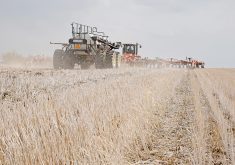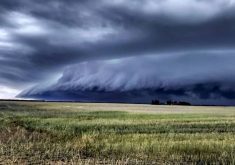The Goods and Services Tax affects all farmers in the Western provinces. The basic rule is that you must be registered for the GST if you have GST-taxable sales (either five percent taxable or zero-rated) over $30,000 in the last four quarters.
In most cases, the agricultural goods that you sell are considered zero-rated, that is, taxable at zero percent, which means you are not required to charge GST.
Although many of your sales are zero-rated there are still instances where you would be required to collect GST. These include cash rent of land, the sale of certain equipment, and the sale of land, although there are special rules for GST on land sales in which GST may not have to actually be collected, paid and claimed.
Read Also

Fuel rebate rule change will affect taxes and AgriStability
The federal government recently announced updates to the fuel rebates that farmers have been receiving since 2019-20.
If your farm is required to charge GST for its products or services and does not have many input tax credits, for example if you are cash renting out your farm land, you may benefit from electing to file your GST return using what is called the Quick Method.
This is simply a different method for small businesses of calculating the GST and possibly simplifying recordkeeping for GST.
To use the Quick Method you must meet several conditions and file an election with the government. This can be found on the Canada Revenue Agency website or you can talk to your qualified sales tax professional.
Under the Quick Method, your farm must still charge and collect the GST at the normal rate.
However, instead of remitting the total GST collected minus total GST paid, a flat prescribed percentage of sales is used to determine the amount of GST to remit.
There are exceptions, such as the purchase of equipment, that would allow you to claim the full GST paid as an input tax credit on certain items.
The remittance percentages vary depending on whether your farm primarily sells goods or services and if your farm operates exclusively outside of provinces that the Harmonized Sales Tax (HST) applies, exclusively in provinces that HST applies, or in multiple provinces.
An example of using the Quick Method is as follows:
John, who is a GST registrant, rents out farm land in Alberta. The cash rent was $50,000 this year and therefore he collected $2,500 in GST from his renters. His GST-taxable expenses this year were $2,000, on which he paid $100 of GST.
Under the traditional GST remittance, John would have to remit $2,400 ($2,500 – $100) to the government. Under the Quick Method of calculating GST, John would have to remit only about $1,590 in GST. This would result in cash savings of $810.
Most traditional farming businesses will not benefit from the Quick Method of calculating GST because the goods they sell are zero-rated and so there is no GST to collect and remit.
Also, they can claim input tax credits for the full amount of the GST they have paid, which results in a refund.
Every businesses is different, so we recommend that you seek professional advice to ensure you are making the correct decisions regarding the administration of the GST.
Riley Honess and Barrett Bettger of KPMG contributed to this article.
Colin Miller is a chartered accountant and partner with KPMG’s tax practice in Lethbridge. Contact: colinmiller@kpmg.ca.














